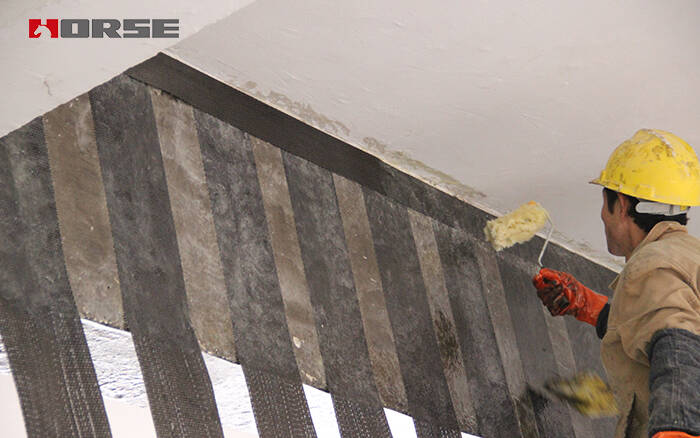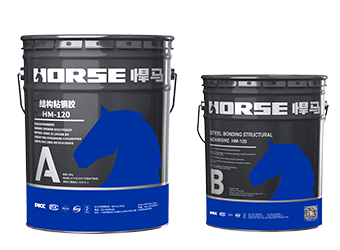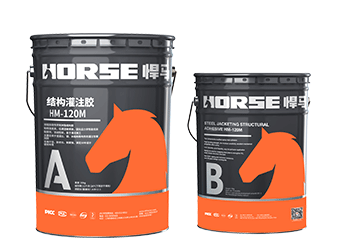Solutions
Horse Construction offers full range of structural strengthening materials with technical supports, documentation supports, products supports, project supports.
Strengthening Method For Insufficient Bearing Capacity Of Beams

The repair and reinforcement of old buildings is an important aspect of the sustainable development of the construction industry. Aiming at the problem of insufficient bearing capacity of reinforced concrete beams in old buildings, six common reinforcement methods are introduced. Enlarged beam section reinforcement method, external steel reinforcement method, sticking steel plate reinforcement method, sticking carbon fiber sheet reinforcement method, variable beam transfer path reinforcement method, external prestressing reinforcement method, etc.
1. Reinforcement method of enlarged beam section
The reinforcement method of increasing the beam section refers to increasing the main reinforcement, shotcrete, cast-in-situ concrete and outer concrete to increase the size of the concrete beam section. The purpose of this method is to increase the moment of inertia or geometric bending modulus of the beam section, reduce the stress of the beam section by changing the section area, and achieve the purpose of strengthening.
The reinforcement method with enlarged section has simple construction technology, strong adaptability and mature design and construction experience. However, the wet operation on site takes a long time, which will have a certain impact on production and life, and the headroom of steel buildings will be reduced.
2 External reinforcement method
The steel clad reinforcement method refers to the method of reinforcing steel bars in concrete beams, which is called Zhou Baoyi. It can be divided into two forms: the dry steel clad method and the wet steel clad method. When the steel and concrete beams are bonded with chemical adhesives, it is called the wet wrapped steel method; when there is no bonding, it is called the dry wrapped steel method.
The method of strengthening concrete beams with steel clad steel has the advantages of large reinforcement range and wide application range, but there are also problems such as large differences between design calculation and actual stress conditions, high requirements for joint processing, large steel consumption and relatively high cost. Higher limitation of reinforcement construction. In order to ensure the stress transmission, both ends must be reliably anchored on the load-bearing column when the beam is strengthened by the wrapped steel method. This often leads to some additional cost of column cladding steel in actual projects, so this method is more suitable for beam columns. For reinforcement works. Theoretically, this strengthening method is suitable for strengthening any beam with insufficient strength, but in practical projects, it is necessary to balance the strengthening effect, strengthening scope and cost. This method is more appropriate when:
1) When beams and columns need to be reinforced at the same time, especially when the beam itself has low strength, it should be preferred;
2) When the beam defects are widely distributed, the strengthening range is large, the cost of other methods is higher, and the cost of external steel method is relatively low;
3) When the structure at both ends of the girder can provide good anchorage conditions and the girder needs to be strengthened to a greater extent, it can also be used;
4) Although beams need to be strengthened, beams and columns need to be strengthened at the same time. The cost of strengthening beams with external steel method is relatively low or the construction conditions are good.

3. Reinforcement method with steel plate
When the bearing capacity of reinforced concrete members is insufficient or the normal use of the structure is affected, the method of pasting steel plate reinforcement is to paste the steel plate at an appropriate position outside the reinforced concrete members through adhesive (building structural adhesive). Due to excessive deformation or cracks. Technical measures to meet the requirements of structural bearing capacity or normal use.
The method of strengthening with steel plate has the advantages of not affecting the appearance of reinforced concrete members, short reinforcement period and quick effect, but also has the disadvantages of complex construction, high quality requirements and high reinforcement unit price. The girder shall be pasted with steel plates before construction. According to the reinforcement mechanism, it is required to restore the deformation of the girder under load, namely unloading. This is difficult in many cases. The appropriate and inappropriate cases of this method are listed below:
1) If it is required that the appearance of the strengthened beam is not affected, and the strengthening cost is next, the steel plate method must be used for strengthening;
2) The beam cracks due to accidental factors will not affect its serviceability. However, when the safety level is low, the method of sticking steel plates for strengthening has the advantages of less work amount and relatively low cost;
3) The method of sticking steel plates is applicable to the reinforcement of main beams under static action. The ambient temperature is not more than 60 ℃, the relative humidity is not more than 70%, and there is no chemical corrosion effect;
4) When the beam section stiffness is too low, the beam cracks are widely distributed, and the width is large, this method should not be used for reinforcement;
5) When the concrete strength grade of the component is lower than C15, this method is not required in the reinforcement technical specification.
4 Reinforcement method of externally bonded carbon fiber
The strengthening method of sticking carbon fiber sheet refers to the use of high-performance adhesive to stick carbon fiber sheet (CFRP) to the external surface of the beam. The two can work together to improve the bearing capacity (bending and shear resistance) of the beam and achieve the purpose of strengthening the beam.
It is reinforced with carbon fiber cloth, with high strength, light weight, good effect, good corrosion resistance and durability, no obvious change in appearance and size, and good flexibility. It has the advantages of easy cutting, wide application range, simple construction (no need for large construction institutions and turnover materials), convenient operation, good economy, short construction period, etc. It has broad application prospects.
5 Change the beam transmission mode and strengthening mode
The reinforcement method of changing the beam transmission mode refers to the method of adding columns or joists (supports) in the middle of the beam, so that the simply supported beam becomes a multi span continuous beam. Changing the transmission mode of the beam can greatly reduce the internal force of the beam section, increase the bearing capacity of the beam, and achieve the purpose of strengthening the original structure.
The columns used for strengthening beams are usually reinforced concrete columns, steel pipe columns or shaped steel columns, and the brackets and joists are usually reinforced concrete structures or steel structures. According to the different support stiffness of the additional fulcrum, there are two types of rigid support and elastic support. Rigid bearing refers to the bearing whose stiffness is large enough to make the vertical displacement of the reinforced structure very small under the action of external load. Elastic support means that the relative stiffness of the added support rod or bracket is not large, and the displacement of the support point can not be ignored, which should be calculated as elastic support.
This method is simple and reliable, but it is easy to damage the original appearance and use function of the building, and may reduce the use space, so it is only applicable to the reinforcement of large-span structures with unrestricted room clearance
6 External prestressing reinforcement method
The external prestressing reinforcement method is a method that uses external prestressing tie rods or struts to strengthen structural members or the whole structure. The mechanical principle is the same as that of unbonded prestressing. The main difference lies in the structural form of the structure. The unbonded prestress directly transfers the force to the structural member through the prestressed reinforcement, and the external prestress transfers the force to the structural member through the anchor bolt and steering block. The external prestressed reinforcement changes the stress state of the structure by applying external force to the structure. The external prestressing tendons work together with the original structure, significantly improving the bearing capacity of the structure.
The external prestressed reinforcement has the function of strengthening the unloading and changing the internal force of the structure. At the same time, it has the characteristics of simple construction, short reinforcement period, no increase in structural size, dead weight, low cost, and no impact on the use of the structure. In recent years, it has been increasingly used to strengthen building beams.
You can find anything here you are in need of, have a trust trying on these products, you will find the big difference after that.

Two-component epoxy modified epoxy structural strengthening adhesive for bonded steel plate to concrete

Modified epoxy resin structural perfusion adhesive, specifically for supporting adhesive bonded steel reinforcement

High strength, unidirectional carbon fiber sheet pre-saturated to form a carbon fiber reinforced polymer (CFRP) sheet used to strengthen structural concrete elements.